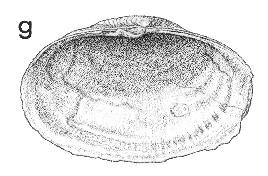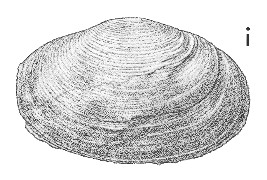
Revised descriptions of New Zealand Cenozoic Mollusca from Beu and Maxwell (1990)

 | Revised descriptions of New Zealand Cenozoic Mollusca from Beu and Maxwell (1990) | 
|
  (Pl. 46g): holotype, "upper beds, Wanganui", Castlecliffian (TM4863, GNS) |
  (Pl. 46i): holotype, "upper beds, Wanganui", Castlecliffian (TM4863, GNS) |
Beu & Maxwell (1990): Chapter 16; p. 346; pl. 46 g,i.
Synonymy: Thracia granulosa Hutton 1973b, p. 19 (not of A. Adams & Reeve, 1850); Thracia neozelanica Suter 1914, p. 54 (new name for Thracia granulosa Hutton, preoccupied)
Classification: New genus of Parilimyidae
Description: Small for family (43-48 mm long), thin and fragile, evenly elongate-oval and very inflated, except for slight anterior rostration on some specimens; umbo central, only slightly elevated; both anterior and posterior ends gape slightly. Exterior sculptured with many weak, irregular, commarginal growth sulci; entire surface closely and microscopically granulous; granules of posterior end tend to be disposed in radial rows. Hinge plate thin and smooth, apart from a low nymph just behind umbo, separated from hinge plate by deep, narrow groove. Anterior adductor scar small, narrowly oval; posterior one wider. Pallial line irregular, with transverse ridges; shallow, almost rectangular pallial sinus below posterior adductor scar. Siphonal retractor (taenioid) muscle scar small but obvious, at anterior third of shell length.
Comparison: The taxonomic position of "Thracia" neozelanica has been in doubt; it certainly does not belong in the Thraciidae, and a position in Parilimyidae seems appropriate. The position of several New Zealand "Pholadomya" species in Parilimya was discussed under Pholadomya neozelanica. The present species differs from Parilimya species in its longer and lower shape, with almost equal anterior and posterior ends, and in its relatively thick shell lacking radial sculpture, and appears to belong in an unnamed genus. The siphonal retractor muscle scar characteristic of Parilimyidae is prominent. The relatively coarsely granulose surface makes "Parilimya" neozelanica easily recognised.
Distribution: Castlecliffian-Recent; "Wanganui (upper beds)", i.e., upper part of the section at Castlecliff, Wanganui, Castlecliffian (type). A rare but interesting species known fossil as only three or four valves, all from the late Castlecliffian of Castlecliff, Wanganui; recently collected specimens are from Pinnacle Sand (Boreham 1965, pl. 20, fig. 2, 3) and Upper Castlecliff Shellbed. Modern specimens in NMNZ are from 40-180 m on the shelf around much of New Zealand, but are very rare.
Cite this publication as: "A.G. Beu and J.I. Raine (2009). Revised
descriptions of New Zealand Cenozoic Mollusca from Beu and Maxwell (1990). GNS
Science miscellaneous series no. 27."
© GNS Science, 2009
ISBN
978-0-478-19705-1
ISSN 1177-2441
(Included with a PDF facsimile file
copy of New Zealand Geological Survey Paleontological Bulletin 58 in CD version
from: Publications Officer, GNS Science, P.O. Box 30368 Lower Hutt, New
Zealand)